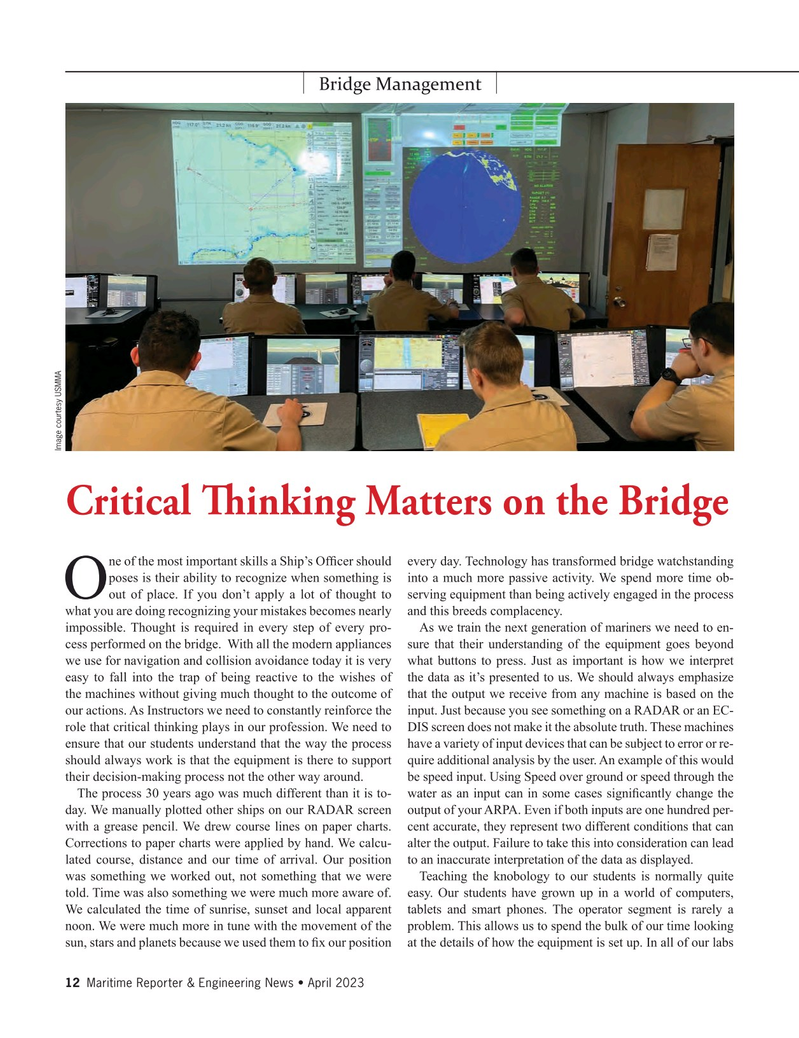
Page 12: of Maritime Reporter Magazine (April 2023)
Cruise Shipping
Read this page in Pdf, Flash or Html5 edition of April 2023 Maritime Reporter Magazine
Bridge anageent
Image courtesy USMMA
Critical ! inking Matters on the Bridge ne of the most important skills a Ship’s Of? cer should every day. Technology has transformed bridge watchstanding poses is their ability to recognize when something is into a much more passive activity. We spend more time ob-
Oout of place. If you don’t apply a lot of thought to serving equipment than being actively engaged in the process what you are doing recognizing your mistakes becomes nearly and this breeds complacency. impossible. Thought is required in every step of every pro- As we train the next generation of mariners we need to en- cess performed on the bridge. With all the modern appliances sure that their understanding of the equipment goes beyond we use for navigation and collision avoidance today it is very what buttons to press. Just as important is how we interpret easy to fall into the trap of being reactive to the wishes of the data as it’s presented to us. We should always emphasize the machines without giving much thought to the outcome of that the output we receive from any machine is based on the our actions. As Instructors we need to constantly reinforce the input. Just because you see something on a RADAR or an EC- role that critical thinking plays in our profession. We need to DIS screen does not make it the absolute truth. These machines ensure that our students understand that the way the process have a variety of input devices that can be subject to error or re- should always work is that the equipment is there to support quire additional analysis by the user. An example of this would their decision-making process not the other way around. be speed input. Using Speed over ground or speed through the
The process 30 years ago was much different than it is to- water as an input can in some cases signi? cantly change the day. We manually plotted other ships on our RADAR screen output of your ARPA. Even if both inputs are one hundred per- with a grease pencil. We drew course lines on paper charts. cent accurate, they represent two different conditions that can
Corrections to paper charts were applied by hand. We calcu- alter the output. Failure to take this into consideration can lead lated course, distance and our time of arrival. Our position to an inaccurate interpretation of the data as displayed. was something we worked out, not something that we were Teaching the knobology to our students is normally quite told. Time was also something we were much more aware of. easy. Our students have grown up in a world of computers,
We calculated the time of sunrise, sunset and local apparent tablets and smart phones. The operator segment is rarely a noon. We were much more in tune with the movement of the problem. This allows us to spend the bulk of our time looking sun, stars and planets because we used them to ? x our position at the details of how the equipment is set up. In all of our labs 12 Maritime Reporter & Engineering News • April 2023
MR #4 (1-17).indd 12 4/5/2023 8:37:05 AM

 11
11

 13
13
